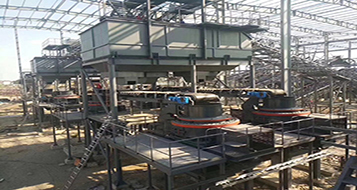Crushing and grinding are essential steps in the processing of iron ore to prepare it for beneficiation and further use in steel production. Here’s an overview of the process:
1. Crushing of Iron Ore
Iron ore is typically mined in large chunks (up to 1.5 meters in diameter) and must be reduced to smaller sizes for efficient grinding and beneficiation.
 # Primary Crushing:
# Primary Crushing:
– Jaw Crushers or Gyratory Crushers are commonly used to break down large iron ore lumps into smaller pieces (~150–250 mm).
– Impact Crushers may also be used for softer ores.
# Secondary & Tertiary Crushing:
– Cone Crushers or High-Pressure Grinding Rolls (HPGR) further reduce the ore to ~10–50 mm.
– Screening is often used between crushing stages to separate fine material early.
2. Grinding of Iron Ore
Grinding reduces the crushed ore to fine particles (typically below 0.075 mm) to liberate iron minerals from gangue (waste rock).
# Common Grinding Methods:
– Ball Mills: Most widely used for iron ore grinding, using steel balls to pulverize the material.
– Rod Mills: Sometimes used for coarser grinding before ball milling.
– Autogenous (AG) & Semi-Autogenous (SAG) Mills: Use the ore itself as grinding media, reducing energy consumption Vertimills/Stirred Mills: Energy-efficient for fine grinding.
Vertimills/Stirred Mills: Energy-efficient for fine grinding.
# Closed-Circuit Grinding:
– Ground material is classified using hydrocyclones or screens.
– Oversized particles are returned for regrinding, ensuring optimal fineness.
3. Key Considerations for Iron Ore Crushing & Grinding
– Energy Efficiency: HPGRs and stirred mills can reduce energy consumption compared to traditional ball mills.
– Ore Hardness: Magnetite is harder than hematite, requiring more power.
– Particle Size Control: Over-grinding can lead to slimes, making beneficiation difficult.
– Moisture Content: Wet grinding is common but may require dewatering later.
4. Typical Final Product Sizes
– For direct shipping ore (DSO): ~30–50 mm (minimal crushing needed).
– For beneficiation (magnetic separation/flotation): ~80% passing 75 microns (~200 mesh).





Leave a Reply